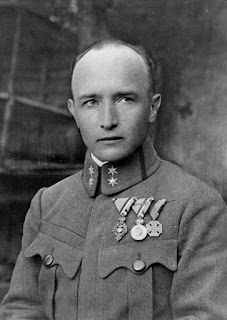.png) |
| The k.u.k Dobbeladler |
 |
| Robert Musil as k.u.k Offizier. |
That year and the year before, crucial events took place in Kaisertum Österreich, the Austrian Empire. The short war with Prussia in 1866 ended in disaster, and the Hungarians exploited the situation to demand parity with Austria. This led to the 1867 Ausgleich which granted The Kingdom of Hungary full control of internal affairs. Only foreign policy and defence were left in common institutions. Head of state was still Franz Joseph I but from now on he was emperor only in the Austrian part of the Empire. He was crowned king I Ferenc Jószef of Hungary the same year. The armed forces, as a common institution, subsequently became Kaiserlich und Königlich shortened to k.k or often k.u.k. These terms will of course be familiar to readers of Švejk. Even though the good Czech soldier and loyal subject served his Austrian Emperor, he served in the k.k army. The abbreviation k.k also gave rise to the expression Kakanien, immortalised in Robert Musil's unfinished masterpiece Mann ohne Eigenschaften (The Man without qualities). The new political entity didn't even have a manageable official name. For years it was officially known as Die im Reichsrat vertretenen Königreiche und die Länder der Heiligen Ungarischen Stephanskrone. Informally it was shortened to Austria-Hungary, the Dual Monarchy or the Danube Monarchy. Hungarians must have me excused for not providing a translation...
The river Leitha is not a major river, being only 180 km long. Still, it's name got far more famous than it's murky waters merited. Leitha became the political border between the Austrian and Hungarian parts of the Empire. The two parts subsequently became known as Cisleithanien and Transleithanien. As the names indicate, this was seen from the Austrian side! Not that Leitha formed the border all the way, the Austrian domains of Galicia and Bukovina were east of Hungary and geographically the Carpathians was the most important divide between the Empire of Austria and the Kingdom of Hungary.
 |
| Cisleithanien in red |
The 1867 Ausgleich affected Bruck an der Leitha dramatically. The eastern part with Brucker Lager and the railway station became part of Hungary, and with the policies of magyarisation the settlement east of the Leitha changed it's name twice: in 1898 it became Uj-Bruck (New Bruck) and in 1902 it was given the name Királyhida (Kings Bridge) which is so familiar to readers of Švejk. There was even in those times confusion on the naming and distinction between Bruck and Királyhida. Old Hungarian post-cards from Bruck are titled Királyhida and Hašek is himself muddled. Although he at one stage explicitly states that these are two towns, he at other times mixes them up.



I enjoyed reading this blog as much as I did with all the previous ones. Let me make just a comment or two to it:
ReplyDelete"k.k." and "k.u.k." are NOT synonyms:
k.k. (kaiserlich königlich) before the "Ausgleich" was used for all institutions covering the whole empire. After the "Ausgleich" these were called "k.u.k." (kaiserlich und königlich), whereas "k.k." was used for institutions of the Austrian (cis-leithanian) part only.
The (never official) terminology of "Cis-Leithanien" and "Trans-Leithanien" might have been formed in analogy to the ancient Roman division of Gallia in ”Gallia cisalpina” (=Northwestern Italy) and ”Gallia transalpina” (=France). If I rember correctly Caesar’s ”De bello gallico” beginns with the words 'Gallia omnia divisa est in partes tres quarum ununm incolunt belgae ...' The other two are the cis- and the transalpine Gallia.
Looking foreward to many more interesting blogs and wishing "Bon voyage"
Hans-Peter Laqueur
Than you both, Mr. Hønsi and Mr. Laqueur, for the information. It is much appreciated.
ReplyDelete